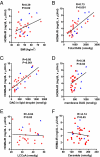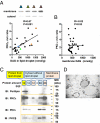Cellular mechanism of insulin resistance in nonalcoholic fatty liver disease - PubMed (original) (raw)
. 2011 Sep 27;108(39):16381-5.
doi: 10.1073/pnas.1113359108. Epub 2011 Sep 19.
Derek M Erion, Dongyan Zhang, Mario Kahn, Sara A Beddow, Xin Chu, Christopher D Still, Glenn S Gerhard, Xianlin Han, James Dziura, Kitt Falk Petersen, Varman T Samuel, Gerald I Shulman
Affiliations
- PMID: 21930939
- PMCID: PMC3182681
- DOI: 10.1073/pnas.1113359108
Cellular mechanism of insulin resistance in nonalcoholic fatty liver disease
Naoki Kumashiro et al. Proc Natl Acad Sci U S A. 2011.
Abstract
Insulin resistance is associated with nonalcoholic fatty liver disease (NAFLD) and is a major factor in the pathogenesis of type 2 diabetes. The development of hepatic insulin resistance has been ascribed to multiple causes, including inflammation, endoplasmic reticulum (ER) stress, and accumulation of hepatocellular lipids in animal models of NAFLD. However, it is unknown whether these same cellular mechanisms link insulin resistance to hepatic steatosis in humans. To examine the cellular mechanisms that link hepatic steatosis to insulin resistance, we comprehensively assessed each of these pathways by using flash-frozen liver biopsies obtained from 37 obese, nondiabetic individuals and correlating key hepatic and plasma markers of inflammation, ER stress, and lipids with the homeostatic model assessment of insulin resistance index. We found that hepatic diacylglycerol (DAG) content in cytoplasmic lipid droplets was the best predictor of insulin resistance (R = 0.80, P < 0.001), and it was responsible for 64% of the variability in insulin sensitivity. Hepatic DAG content was also strongly correlated with activation of hepatic PKCε (R = 0.67, P < 0.001), which impairs insulin signaling. In contrast, there was no significant association between insulin resistance and other putative lipid metabolites or plasma or hepatic markers of inflammation. ER stress markers were only partly correlated with insulin resistance. In conclusion, these data show that hepatic DAG content in lipid droplets is the best predictor of insulin resistance in humans, and they support the hypothesis that NAFLD-associated hepatic insulin resistance is caused by an increase in hepatic DAG content, which results in activation of PKCε.
Conflict of interest statement
The authors declare no conflict of interest.
Figures
Fig. 1.
DAG content in lipid droplets was the strongest predictor of insulin resistance. DAG, diacylglycerol; HOMA-IR, homeostatic model assessment of insulin resistance index; LCCoA, long-chain fatty acyl-CoA. Red dots and blue triangles show females and males, respectively. n = 35, 35, 28, 28, 28, and 32 for A, B, C, D, E, and F, respectively.
Fig. 2.
PKCε activation was strongly correlated with DAG content in lipid droplets. m/c, membrane/cytosol. Representative bands are labeled with colors and shown with corresponding colors on the graph (A). Circles and triangles show females and males, respectively (A). n = 30 for both A and B. Lipid droplet fraction was confirmed with Western blotting (C) and EM (D).
Fig. 3.
Correlation between ER stress markers and HOMA-IR. The relative expression level was expressed by setting the lowest expression level as one (A and B). Representative bands are labeled with colors and shown with corresponding colors on the graph (A and B). n = 30 and 25 for A and B, respectively.
Similar articles
- CGI-58 knockdown sequesters diacylglycerols in lipid droplets/ER-preventing diacylglycerol-mediated hepatic insulin resistance.
Cantley JL, Yoshimura T, Camporez JP, Zhang D, Jornayvaz FR, Kumashiro N, Guebre-Egziabher F, Jurczak MJ, Kahn M, Guigni BA, Serr J, Hankin J, Murphy RC, Cline GW, Bhanot S, Manchem VP, Brown JM, Samuel VT, Shulman GI. Cantley JL, et al. Proc Natl Acad Sci U S A. 2013 Jan 29;110(5):1869-74. doi: 10.1073/pnas.1219456110. Epub 2013 Jan 9. Proc Natl Acad Sci U S A. 2013. PMID: 23302688 Free PMC article. - Hepatic Diacylglycerol-Associated Protein Kinase Cε Translocation Links Hepatic Steatosis to Hepatic Insulin Resistance in Humans.
Ter Horst KW, Gilijamse PW, Versteeg RI, Ackermans MT, Nederveen AJ, la Fleur SE, Romijn JA, Nieuwdorp M, Zhang D, Samuel VT, Vatner DF, Petersen KF, Shulman GI, Serlie MJ. Ter Horst KW, et al. Cell Rep. 2017 Jun 6;19(10):1997-2004. doi: 10.1016/j.celrep.2017.05.035. Cell Rep. 2017. PMID: 28591572 Free PMC article. - Nonalcoholic fatty liver disease, hepatic insulin resistance, and type 2 diabetes.
Birkenfeld AL, Shulman GI. Birkenfeld AL, et al. Hepatology. 2014 Feb;59(2):713-23. doi: 10.1002/hep.26672. Hepatology. 2014. PMID: 23929732 Free PMC article. Review. - Diacylglycerol activation of protein kinase Cε and hepatic insulin resistance.
Jornayvaz FR, Shulman GI. Jornayvaz FR, et al. Cell Metab. 2012 May 2;15(5):574-84. doi: 10.1016/j.cmet.2012.03.005. Cell Metab. 2012. PMID: 22560210 Free PMC article. Review. - Hepatic insulin resistance in mice with hepatic overexpression of diacylglycerol acyltransferase 2.
Jornayvaz FR, Birkenfeld AL, Jurczak MJ, Kanda S, Guigni BA, Jiang DC, Zhang D, Lee HY, Samuel VT, Shulman GI. Jornayvaz FR, et al. Proc Natl Acad Sci U S A. 2011 Apr 5;108(14):5748-52. doi: 10.1073/pnas.1103451108. Epub 2011 Mar 21. Proc Natl Acad Sci U S A. 2011. PMID: 21436037 Free PMC article.
Cited by
- High-fat-diet-induced hepatic insulin resistance per se attenuates murine de novo lipogenesis.
Goedeke L, Strober JW, Suh R, Paolella LM, Li X, Rogers JC, Petersen MC, Nasiri AR, Casals G, Kahn M, Cline GW, Samuel VT, Shulman GI, Vatner DF. Goedeke L, et al. iScience. 2024 Oct 15;27(11):111175. doi: 10.1016/j.isci.2024.111175. eCollection 2024 Nov 15. iScience. 2024. PMID: 39524330 Free PMC article. - No Difference in Liver Damage Induced by Isocaloric Fructose or Glucose in Mice with a High-Fat Diet.
Hsu WF, Lee MH, Lii CK, Peng CY. Hsu WF, et al. Nutrients. 2024 Oct 21;16(20):3571. doi: 10.3390/nu16203571. Nutrients. 2024. PMID: 39458565 Free PMC article. - Appendicular skeletal muscle mass is associated with metabolic dysfunction-associated steatotic liver disease severity in young men: a cross-sectional and longitudinal study.
Lee J, So J, Han CI, Yang H, Sung PS, Bae SH, Song DS. Lee J, et al. Hepatol Int. 2024 Oct 12. doi: 10.1007/s12072-024-10737-8. Online ahead of print. Hepatol Int. 2024. PMID: 39394385 - Nonalcoholic Fatty Liver Disease and Staging of Hepatic Fibrosis.
Engin A. Engin A. Adv Exp Med Biol. 2024;1460:539-574. doi: 10.1007/978-3-031-63657-8_18. Adv Exp Med Biol. 2024. PMID: 39287864 Review. - Intestinal Nogo-B reduces GLP1 levels by binding to proglucagon on the endoplasmic reticulum to inhibit PCSK1 cleavage.
Gong K, Xue C, Feng Z, Pan R, Wang M, Chen S, Chen Y, Guan Y, Dai L, Zhang S, Jiang L, Li L, Wang B, Yin Z, Ma L, Iwakiri Y, Tang J, Liao C, Chen H, Duan Y. Gong K, et al. Nat Commun. 2024 Aug 10;15(1):6845. doi: 10.1038/s41467-024-51352-3. Nat Commun. 2024. PMID: 39122737 Free PMC article.
References
- Grundy SM. Metabolic syndrome pandemic. Arterioscler Thromb Vasc Biol. 2008;28:629–636. - PubMed
- Wild S, Roglic G, Green A, Sicree R, King H. Global prevalence of diabetes: Estimates for the year 2000 and projections for 2030. Diabetes Care. 2004;27:1047–1053. - PubMed
- Cheung O, Sanyal AJ. Recent advances in nonalcoholic fatty liver disease. Curr Opin Gastroenterol. 2010;26:202–208. - PubMed
- Savage DB, Semple RK. Recent insights into fatty liver, metabolic dyslipidaemia and their links to insulin resistance. Curr Opin Lipidol. 2010;21:329–336. - PubMed
Publication types
MeSH terms
Substances
Grants and funding
- UL1 RR024139/RR/NCRR NIH HHS/United States
- R24 DK-085638/DK/NIDDK NIH HHS/United States
- HHMI/Howard Hughes Medical Institute/United States
- UL1 RR-024139/RR/NCRR NIH HHS/United States
- R01 DK088231/DK/NIDDK NIH HHS/United States
- R24 DK085638/DK/NIDDK NIH HHS/United States
- R01 AG023686/AG/NIA NIH HHS/United States
- R01 DK-49230/DK/NIDDK NIH HHS/United States
- R01 AG-23686/AG/NIA NIH HHS/United States
- R01 AG023686-08/AG/NIA NIH HHS/United States
- R01 DK049230/DK/NIDDK NIH HHS/United States
LinkOut - more resources
Full Text Sources
Other Literature Sources


